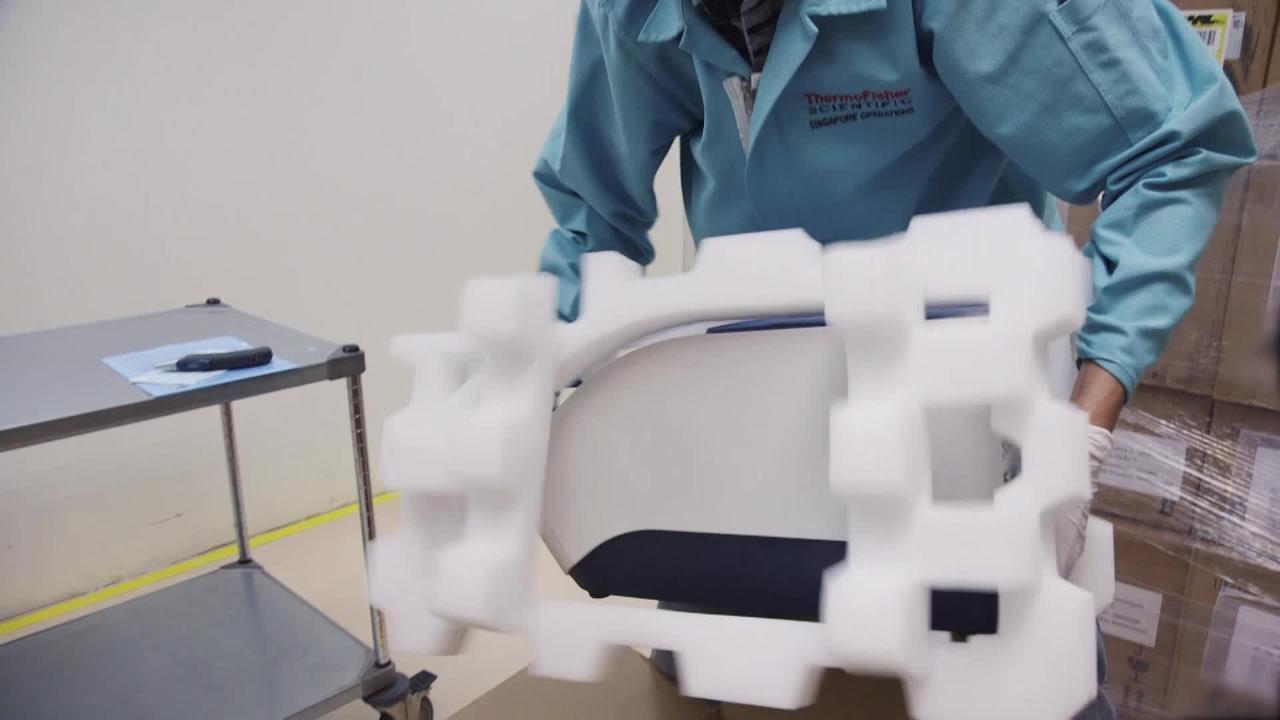Search Thermo Fisher Scientific
PCR Thermal Cyclers Education

Polymerase chain reaction (PCR) is the process of producing millions of copies of nucleic acids from a target sequence. Scientists have replicated this reaction with PCR machines (also known as thermal cyclers or thermocyclers). Learn the history of thermal cyclers since their introduction in the 1980s and advances in PCR technology that help improve PCR results.
What is a PCR machine and what do they do?
A PCR machine—or a thermal cycler—is an instrument that amplifies target nucleic acid sequences into millions of copies via polymerase chain reaction. Thermal cyclers inherit their name because they regulate temperatures in a cyclical program.
How does a thermal cycler work?
Thermal cyclers contain metal blocks that are thermally regulated. Since PCR protocols require different temperatures at different times, thermal cyclers and PCR machines regulate quick heat exchange during the PCR protocol.
Thermal cycler history and evolution
Explore the history of thermal cyclers and the progress for PCR technology over the years, beginning with the introduction of thermal cyclers in the 1980s to interchangeable heating blocks and better-than-gradient technology today.
History of thermal cyclers in early days of PCR
PCR is a ubiquitous laboratory technique of molecular biology used to amplify a target DNA sequence to millions of copies. At the inception of the technology in the early 1980s, DNA amplification by PCR was a time-consuming and laborious process. Thermal cycling steps were performed manually, involving repeated transfers of DNA samples among three large water baths set at different temperatures for denaturation, annealing, and extension. Since heat-stable DNA polymerases were not commonly available at the time, the enzyme had to be replenished after each round.
Therefore, engineers started inventing an all-in-one instrument (thermal cycler) that would help automate the PCR process. The first automated machine developed, called "Mr. Cycle ", resolved the need for manual addition of fresh enzyme after each cycle by using liquid handlers and water baths [1]. In 1987, the first commercial thermal cycler, the TC1 DNA Thermal Cycler from Perkin Elmer Cetus, became available with the ability to program heating and cooling of samples using a metal block (Figure 1). In 1988, the first use of a thermostable enzyme (Taq DNA polymerase) in PCR, using the TC1 thermal cycler, was reported [2]. This paved the way for applications of PCR technology in a wide range of scientific fields, as well as innovations in thermal cyclers that revolutionized molecular biology research.

Thermal cycler evolution and progress
Since the introduction of the TC1 DNA Thermal Cycler, significant progress in PCR technology has been made, providing a variety of features to improve PCR experiments. These features include more precise PCR temperature control, improved optimization features, faster ramp rates, and easier program setup.
a. Better sample handling with heated lid function
In the early development of thermal cyclers, the cooling system relied on a bulky plumbing compressor, which made it impossible to have a small-footprint instrument. Today, solid-state Peltier blocks ;are utilized in thermal cyclers to both heat and cool by controlling the direction of an electrical current (Figure 2). Advanced Peltier systems can heat and cool the block at a fast rate (e.g., 6°C per second for the ProFlex PCR System, enabling fast PCR to complete more PCR runs in a day.
Similarly, a heated lid is a common feature of thermal cyclers to prevent evaporation and condensation of PCR samples during runs. Prior to the introduction of the heated lid, samples were overlaid with mineral oil to achieve the same purpose. In addition to being inconvenient and messy, oil overlays limited the amount of a sample that could be used in downstream applications, because part of the sample had to be left behind to prevent carryover of the oil.
Likewise, many of today’s thermal cyclers are built with flexibility in sample throughput in mind. With interchangeable blocks, a benchtop thermal cycler may accommodate, for example, from one to 480,000 amplification reactions (Figure 3). For high-throughput automation, some thermal cyclers are designed for hands-free operations and integration with robotic liquid-handling platforms.

Figure 3. Interchangeable blocks of a thermal cycler for various throughputs. An example of a thermal cycler with interchangeable blocks is the ProFlex PCR System. Available blocks for this PCR machine include 3 x 32-well, 96-well, dual 96-well, dual 384-well, and dual flat blocks.
b. More precise and consistent PCR optimization for better results
Since annealing of primers to the target sequence is critical to obtaining successful PCR results, the temperature for the annealing step often requires optimization. To examine different temperatures simultaneously, gradient thermal blocks were developed, which are designed to enable setting desired low and high temperatures around the theoretical annealing point at the two ends of a single metal block (Figure 4A). “Better-than-gradient” technology has been developed, in which insulated separate metal blocks replace a single block (Figure 4B). This allows more precise temperature control for faster optimization.
In addition to block technology, algorithms to control sample temperatures have improved over the years. Complex mathematical models are applied for more precise regulation of block temperatures to achieve uniform heating and cooling of the PCR samples. This innovation involves measuring the temperature of the samples themselves, in addition to the temperature of the thermal block.
Application note: Thermal cyclers: key thermal cycling concepts and ramp rates
c. Advanced Peltier blocks for faster ramp rate and run times
“Fast” PCR refers to protocols that dramatically speed up overall PCR run times (Figure 5), typically reducing run times from approximately 2 hours to less than 40 minutes, saving time and increasing throughput. Peltier block elements are a hallmark in the evolution of PCR technology. Faster run times due to advances in the Peltier elements lead to faster ramp rates, as well as heating and cooling of the block and samples, and improved algorithms to control and better predict sample temperatures.
These instrument improvements, along with innovations in PCR consumables and reagents, such as ultrathin-walled low-profile PCR plastics and highly processive engineered DNA polymerases, have significantly enabled and improved fast PCR.
Application note: Thermal cyclers: key thermal cycling concepts and ramp rates
d. Easier PCR setup, enhanced accessibility
Thermal cyclers today are designed for easy programming of PCR protocols. PCR protocols often vary based on the DNA targets, primer sequences, DNA polymerases used, and experimental goals. Therefore, thermal cyclers that are equipped with intuitive user interfaces, such as touch screens and easy programming features, help enable faster and more efficient protocol setup (Figure 6).
Recent advances also allow convenient access to thermal cyclers anytime and from anywhere using a mobile device or desktop computer. Cloud connectivity offers enhanced accessibility at your fingertips and freedom to create and share protocols as well as to schedule, start/stop, and monitor PCR runs.
In summary, thermal cyclers have evolved in PCR technology and design since their introduction in the 1980s. Innovations continue to facilitate improvement in PCR and advances in molecular biology research.
Review six features of thermal cyclers and how to choose the right PCR machine for your lab
Learn more about factors in PCR cycling that can help optimize your experiments
Watch thermal cycler education videos
Additional thermal cycler technical resources
For Research Use Only. Not for use in diagnostic procedures.







